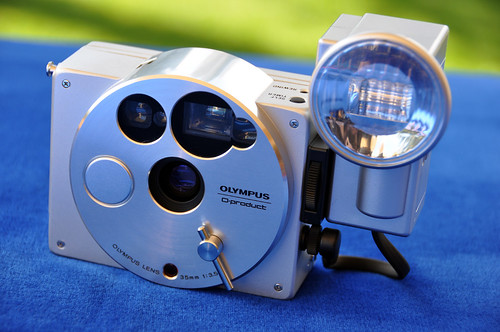Difference between revisions of "Olympus O-Product"
(quick stub to place two CW images; a print source and a link) |
Hanskerensky (talk | contribs) m (Change to get a single image authors name) |
||
| (3 intermediate revisions by 2 users not shown) | |||
| Line 1: | Line 1: | ||
| − | |||
{{Flickr_image | {{Flickr_image | ||
|image_source= http://www.flickr.com/photos/coleccionandocamaras/5571825550/in/pool-camerawiki | |image_source= http://www.flickr.com/photos/coleccionandocamaras/5571825550/in/pool-camerawiki | ||
| Line 5: | Line 4: | ||
|image_align= right | |image_align= right | ||
|image_text= Machine style O-Product | |image_text= Machine style O-Product | ||
| − | |image_by= Coleccionando | + | |image_by= Coleccionando Camaras |
|image_rights= nc | |image_rights= nc | ||
}} | }} | ||
| − | The '''O-Product''' was a retro-styled, aluminum-clad point and shoot camera introduced by [[Olympus]] in 1988 as a limited edition of 20,000 worldwide (half reserved for the Japanese home market). | + | The '''O-Product''' was a retro-styled, aluminum-clad [[point and shoot]] camera introduced by [[Olympus]] in 1988 as a limited edition of 20,000 worldwide (half reserved for the Japanese home market). It was designed by Naoki Sakai of Water Design. The internals were based on the [[Olympus Infinity Jr]]. It has a autofocus 35mm f/3.5 lens that is protected by a built-in lens cap that opens when powering on the camera. The shutter release is on the face of the camera next to the lens. The matching detachable flash unit is made of plastic and connects with a short rubber cable. |
==Sources== | ==Sources== | ||
| Line 15: | Line 14: | ||
==Links== | ==Links== | ||
| − | *[http://www.olympus-global.com/en/corc/history/camera/zoom/#03 Olympus O-product description] and brochure [http://www.olympus-global.com/en/corc/history/image-archives/camera/pdf/zoom_pop09.pdf part one] and [http://www.olympus-global.com/en/corc/history/image-archives/camera/pdf/zoom_pop10.pdf part two] PDFat [http://www.olympus-global.com/en/corc/history/ Olympus Global History] | + | *[https://web.archive.org/web/20110812025731/http://www.olympus-global.com/en/corc/history/camera/zoom/#03 Olympus O-product description] and brochure [https://web.archive.org/web/20150622095608/http://www.olympus-global.com/en/corc/history/image-archives/camera/pdf/zoom_pop09.pdf part one] and [https://web.archive.org/web/20150622095618/http://www.olympus-global.com/en/corc/history/image-archives/camera/pdf/zoom_pop10.pdf part two] PDFat [https://web.archive.org/web/20150426070551/http://www.olympus-global.com/en/corc/history/ Olympus Global History] (archived) |
Revision as of 08:34, 11 June 2020

|
| Machine style O-Product image by Coleccionando Camaras (Image rights) |
The O-Product was a retro-styled, aluminum-clad point and shoot camera introduced by Olympus in 1988 as a limited edition of 20,000 worldwide (half reserved for the Japanese home market). It was designed by Naoki Sakai of Water Design. The internals were based on the Olympus Infinity Jr. It has a autofocus 35mm f/3.5 lens that is protected by a built-in lens cap that opens when powering on the camera. The shutter release is on the face of the camera next to the lens. The matching detachable flash unit is made of plastic and connects with a short rubber cable.
Sources
- "The Story of 'O' " in the Snapshots column, March 1989 Popular Photography (Vol. 96, No. 3; page 14).
Links
- Olympus O-product description and brochure part one and part two PDFat Olympus Global History (archived)

|
| Rear panel dated 1988; serial number image by Hung Do (Image rights) |